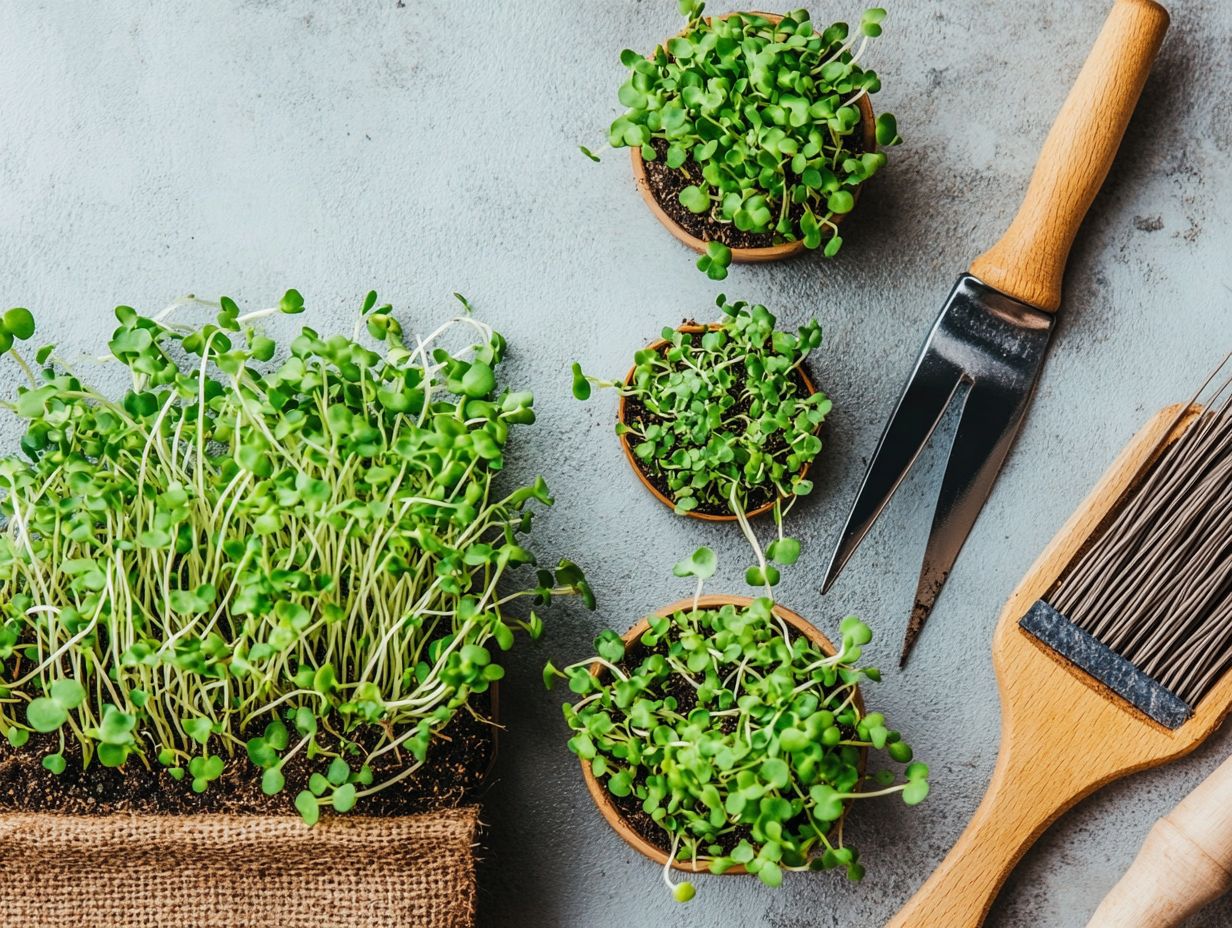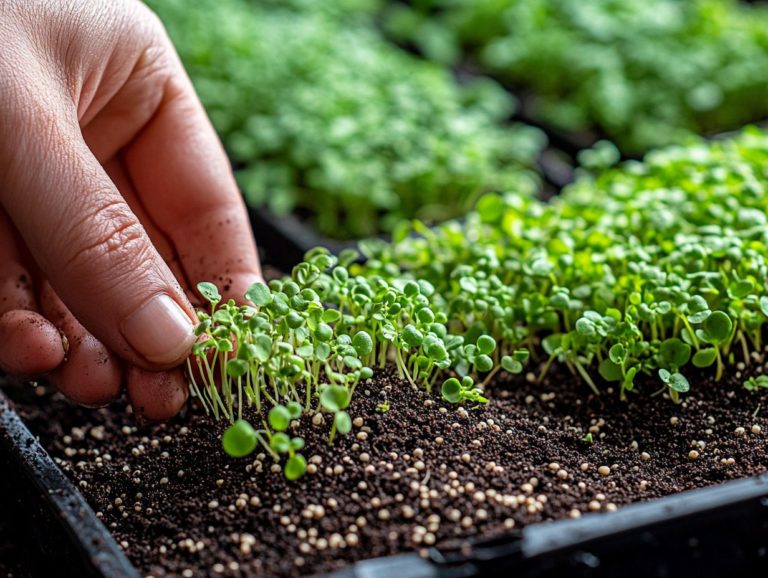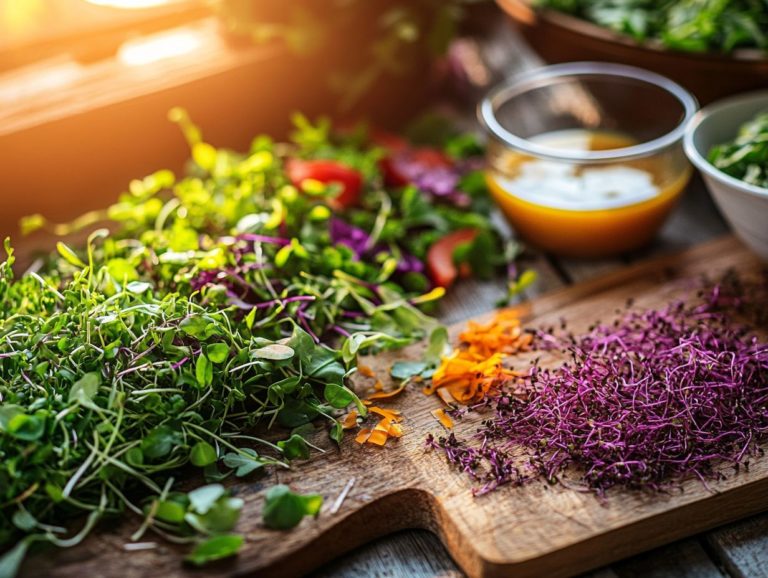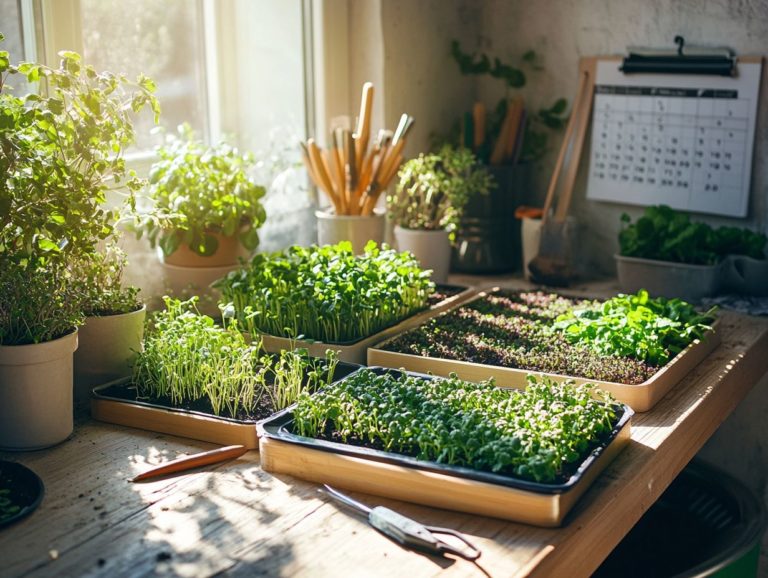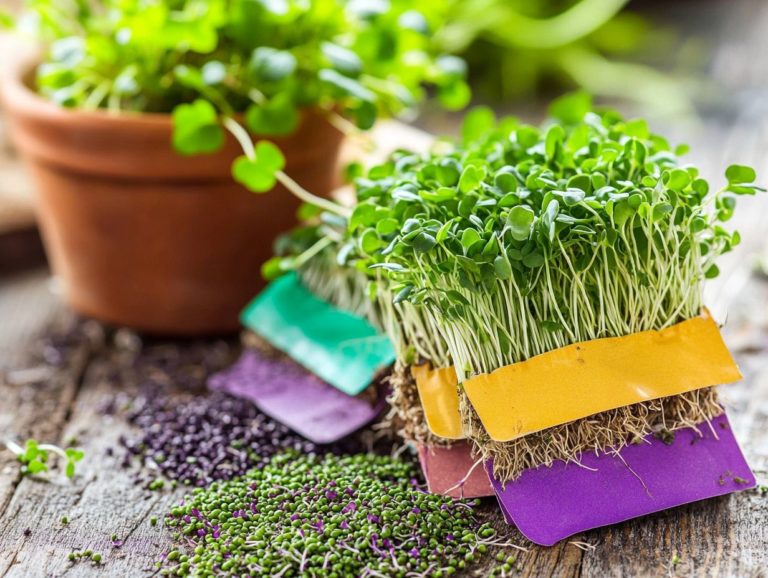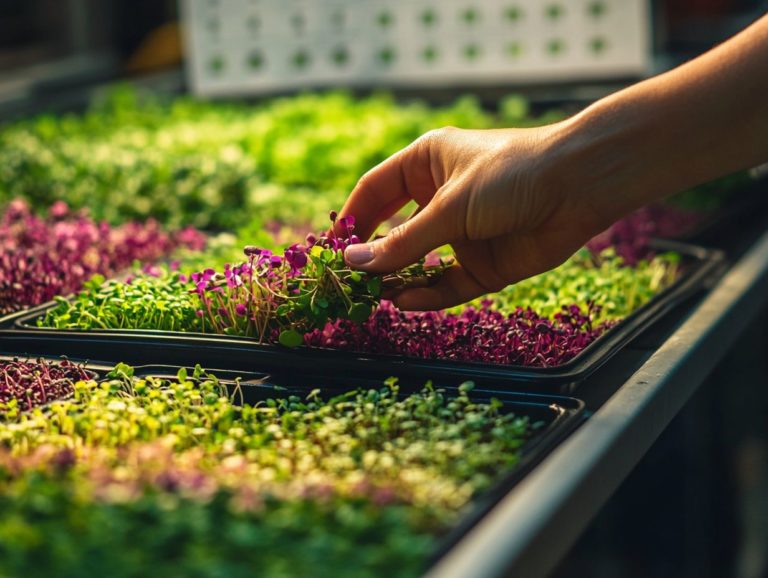Understanding Microgreen Growth Phases
Microgreens are delightful little plants bursting with nutrients that have taken the culinary world by storm. They are celebrated for their vibrant flavors and impressive health benefits.
In this article, you will journey through the stages of microgreen growth, starting from germination and progressing to the development of true leaves. You ll uncover essential factors that play a pivotal role in their growth, including light, temperature, and nutrients.
You will also learn effective harvesting techniques and gain insight into tackling common challenges, such as pests and environmental hurdles. Get ready to take your gardening skills to the next level!
Contents
- Key Takeaways:
- Definition and Uses
- Stages of Microgreen Growth
- Factors Affecting Microgreen Growth
- Harvesting Microgreens
- Common Issues and Solutions
- Frequently Asked Questions
- What are the different growth phases of microgreens?
- What happens during the germination phase of microgreens?
- How long does the growth phase of microgreens last?
- What is the ideal temperature for the growth phase of microgreens?
- What is the maturity phase of microgreens?
- How can I tell when my microgreens are ready for harvest?
Key Takeaways:

- Understanding the three growth phases of microgreens (germination, cotyledon, and true leaf) is essential for successful cultivation.
- Light, temperature, water, and nutrients play crucial roles in the growth of microgreens. Proper management of these factors is essential for optimum growth.
- Timely and proper harvesting techniques, along with careful management of pests, diseases, and environmental factors, are necessary for healthy and high-quality microgreens.
Definition and Uses
Microgreens are the young, edible plants you harvest right after the first true leaves, known as cotyledons, emerge. They are not just celebrated for their striking colors, but also for their intense flavors and nutrient density.
These small yet powerful plants include delightful varieties like pea shoots, radish microgreens, sunflower shoots, and broccoli microgreens. They offer a wealth of health benefits, making them a beloved choice in culinary masterpieces and a must-have in indoor gardens.
With the growing trend of urban farming and a focus on health-conscious eating, you can find them in home kitchens and upscale restaurants.
Stages of Microgreen Growth
The journey of growing microgreens unfolds through several essential stages. It all starts with germination, where seeds eagerly absorb moisture and begin to sprout.
Next is the cotyledon phase, leading up to the true leaf phase, indicating that your plants are ready for harvesting. Each stage is vital to the development of those nutrient-rich greens.
By grasping the specific growing conditions and care required at each phase, you can significantly elevate the success of your microgreen cultivation endeavors.
Germination Phase
The germination phase marks a pivotal beginning in your microgreens journey. Here, organic seeds soak up water and start to sprout. To thrive, they require ideal growing conditions, including moisture and warmth.
For optimal growth, maintain temperatures between 65 F and 75 F. This range encourages effective metabolic activity. Keep a vigilant eye on moisture levels; the soil should stay consistently damp but never waterlogged. Excess water can invite mold or cause seed rot.
Using high-quality organic seeds is crucial; these seeds are more likely to germinate successfully and yield robust plants. Common challenges during this phase include uneven moisture distribution and temperature fluctuations.
To tackle these issues, consider employing a humidity dome to retain moisture and a seedling heat mat to regulate soil warmth. This way, you ensure your young plants have the best possible start.
Cotyledon Phase
During the cotyledon phase, you ll witness microgreens developing their first set of leaves. These leaves, known as cotyledons, are crucial for photosynthesis and represent a pivotal growth moment for various microgreen varieties.
These initial leaves are vital for light absorption and play a key role in nutrient uptake. They enable these tiny plants to harness energy as they establish themselves. Take, for example, varieties like sunflower, pea, and radish they each exhibit rapid growth patterns during this stage, adapting uniquely to their surroundings.
Sunflower microgreens, with their thick, broad cotyledons, excel at absorbing light, while pea microgreens, with delicate textures, flourish in cooler conditions. Radish microgreens grow swiftly and offer a peppery flavor, showcasing how diverse growth habits can be advantageous both in the kitchen and the garden.
True Leaf Phase
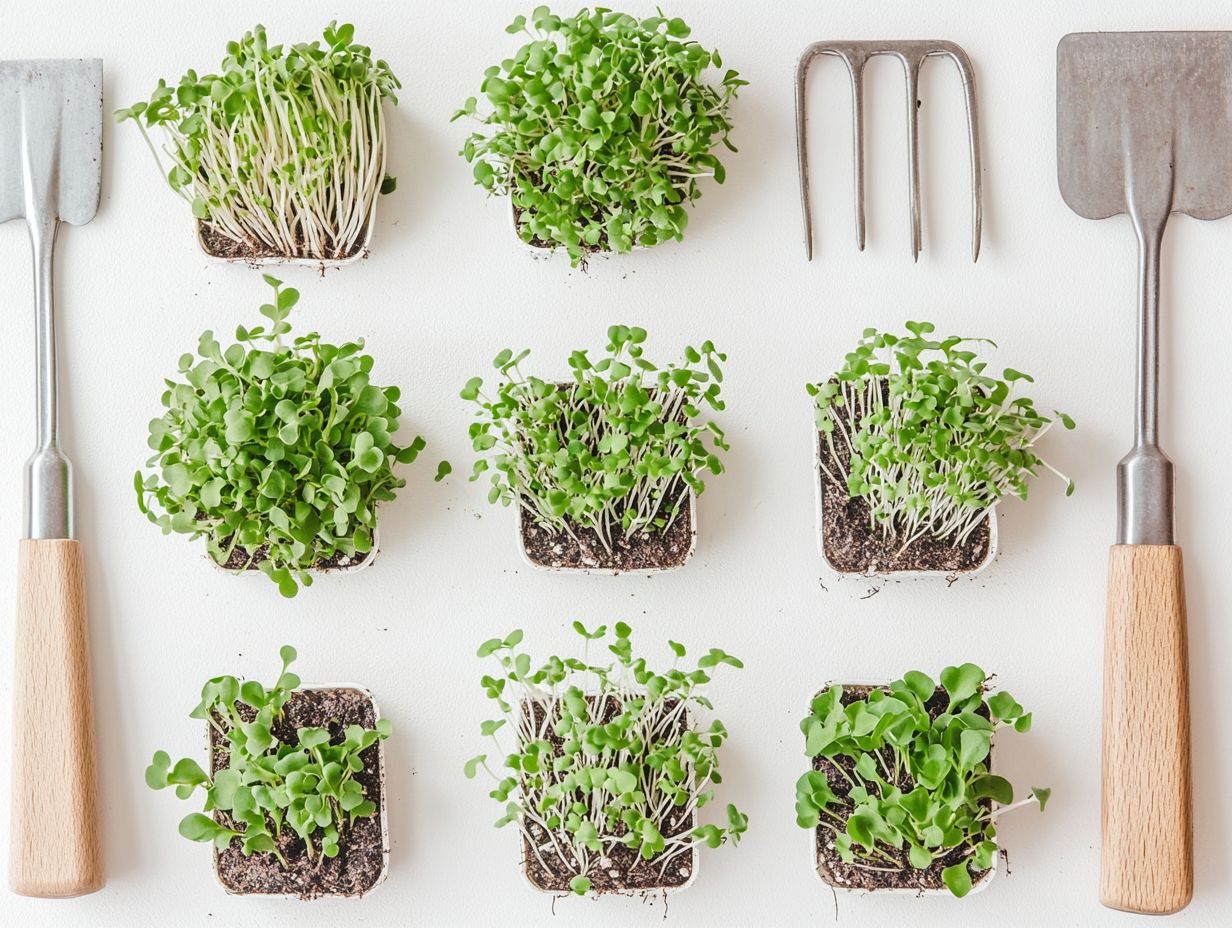
The true leaf phase marks the pinnacle of microgreen growth. Here, your plants begin to sprout their second set of leaves.
This development boosts nutrient production and prepares them for either transplanting into larger containers or harvesting.
During this critical phase, you’ll notice vibrant colors and denser foliage. These are clear indicators of optimal health and impressive growth potential.
This stage usually starts around 10 to 14 days after germination, varying slightly depending on the specific variety.
To create the best growing conditions, ensure your microgreens receive adequate light, are planted in good soil, and maintain consistent moisture levels.
Transitioning your microgreens to larger containers promotes robust root development and reduces competition for nutrients.
Regularly monitoring temperature and humidity will facilitate this transition. This paves the way for a bountiful harvest.
Employing gentle handling techniques during transplanting can significantly enhance your success in this final growth stage.
Factors Affecting Microgreen Growth
Several factors significantly influence the growth of microgreens. Light and temperature take center stage.
Alongside these, water and nutrients play pivotal roles. Together, they establish the ideal conditions essential for flourishing microgreen cultivation.
Light and Temperature
Light and temperature play a crucial role in your microgreens’ success. Optimal exposure to light, especially from special lights that help plants grow indoors, and maintaining the right temperature are essential for encouraging vibrant growth.
Different varieties have their own light preferences. Some thrive in bright, direct illumination, while others benefit from partial shade to prevent scorching.
By understanding these specific needs, you can tailor your growing setup for maximum effectiveness.
The sweet spot for temperature usually lies between 60 F and 75 F. This creates an ideal environment for germination and growth.
If temperatures fluctuate outside this range, you might encounter slow growth, weak stems, or even disease that can compromise your harvest quality.
Insufficient lighting can lead to stunted growth and leggy plants. It’s imperative to keep a close eye on and adjust your conditions as needed.
Water and Nutrients
Water and nutrients are vital for your microgreen cultivation journey. They significantly influence the growth rate, flavor profiles, and overall quality of your plants.
To ensure these delicate greens thrive, provide consistent moisture while avoiding soil saturation.
You ll typically want to water daily, but adjust your routine based on humidity levels and the specific needs of your microgreen variety.
Using high-quality, well-draining growing mediums like coconut coir or peat moss encourages healthy root development and helps prevent rot.
Incorporating natural plant food that helps your greens grow strong like worm castings or fish emulsion guaranteed that your greens receive essential nutrients. This enhances their flavor and nutritional content while supporting sustainable and environmentally friendly growth.
Harvesting Microgreens
Harvesting microgreens at the optimal time is essential for maximizing their health benefits, flavor, and overall quality.
It requires specific techniques designed to minimize damage to the plants. This ensures you enjoy the finest produce possible.
Don’t wait too long! Harvesting at the right time is key for maximum flavor!
Get ready to enjoy the freshest flavors!
Timing and Techniques
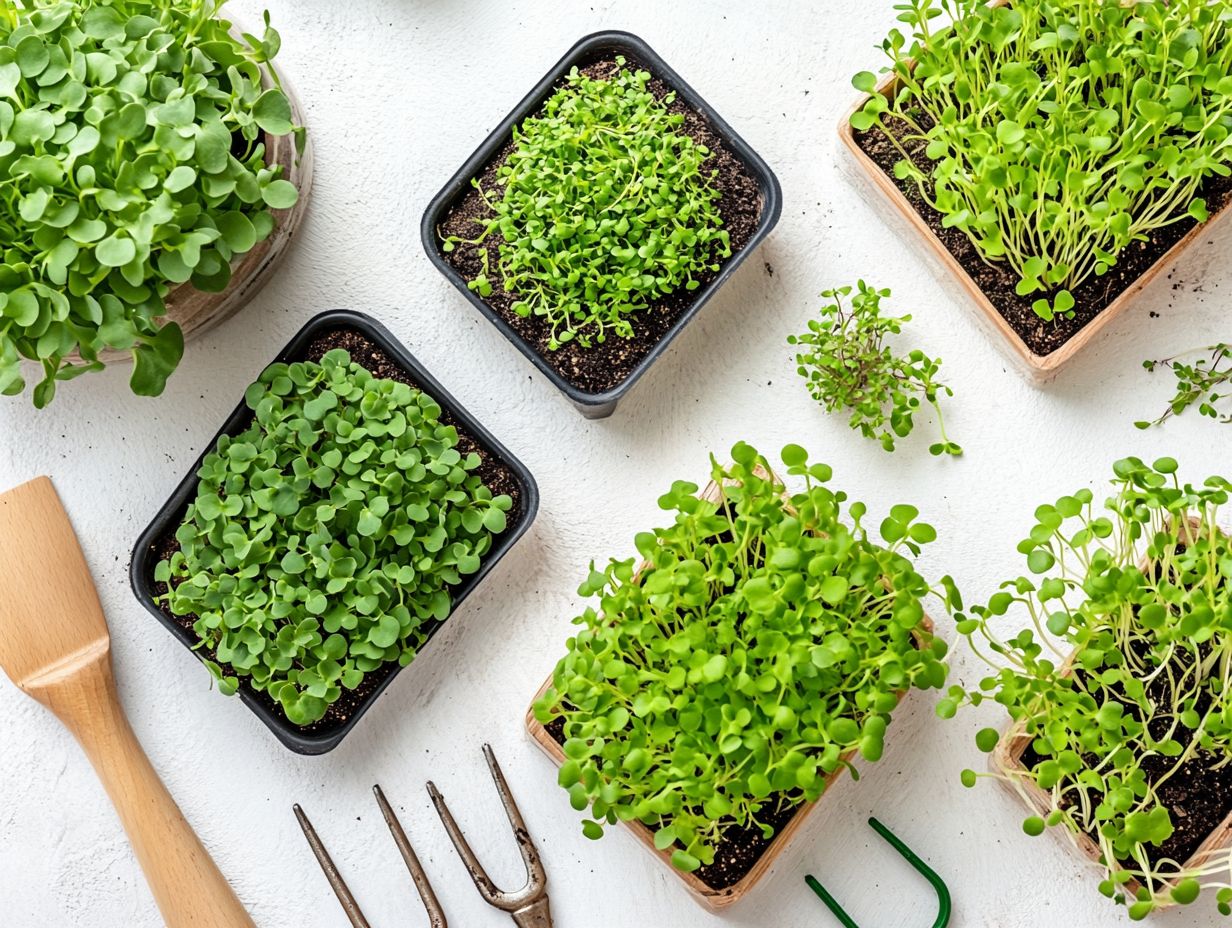
The timing of harvesting microgreens is crucial. Typically, they should be harvested when they reach about 1-3 inches in height.
Use techniques that minimize stress. This can significantly enhance the health benefits these nutrient-packed greens offer.
Observe the growth cycle of each variety. This helps you determine the best times to harvest, as some may mature quicker than others.
Use sharp scissors to cut just above the soil line. This method preserves the roots and encourages regrowth for future harvests.
Maintaining a stable environment in terms of light and moisture levels directly influences the flavor and nutrient density of your microgreens. Regular monitoring and careful handling throughout this process ensure that these vibrant greens retain their essential vitamins and minerals, ultimately benefiting anyone lucky enough to enjoy them. For optimal results, it’s important to understand microgreen harvest timing.
Common Issues and Solutions
You may encounter challenges in growing microgreens, such as pests and diseases, and fluctuating environmental factors. However, effective solutions are available to help you address and mitigate these issues.
Pests and Diseases
Pests and diseases can significantly disrupt your microgreen growing efforts. Common adversaries like aphids and mold pose serious threats. It s essential to adopt ways to keep pests away to safeguard these delicate greens.
Understanding the challenges of microgreen farming is vital for maintaining a flourishing crop. For instance, understanding the growth patterns of microgreen varieties can help you mitigate issues. Aphids don’t just drain the life from your plants; they can also spread harmful pathogens. Mold can quickly take over and ruin an entire batch.
To tackle these issues, consider implementing organic pest control methods, such as introducing beneficial insects or using neem oil, a natural pesticide that helps keep pests away. It s also important to maintain a clean growing environment; regular sanitation and vigilant moisture monitoring can dramatically reduce the risk of infestations while promoting strong growth.
By prioritizing vigilance and cleanliness, you can boost your yields and enjoy healthier microgreens.
Environmental Factors
Environmental factors such as humidity, air circulation, and light exposure play a pivotal role in your microgreen growing success. Pay close attention to these elements to create optimal growing conditions.
Striking the right balance among these factors is crucial; any fluctuations can stress the plants, hindering their growth and reducing yield. For example, maintaining humidity levels between 40-70% is key to helping your microgreens thrive. To learn more about how these conditions affect growth, check out understanding microgreen growth rates. Too much moisture can lead to mold, while too little can stunt their development.
Effective air circulation is another vital aspect that prevents stagnant conditions and promotes healthier plants. To optimize airflow, consider incorporating small fans and arranging your trays to facilitate consistent air movement. Regularly monitoring these conditions will enhance your microgreens’ growth efficiency and ensure they boast robust flavors and vibrant colors.
Frequently Asked Questions
-
What are the different growth phases of microgreens?
Understanding the growth phases of microgreens is essential for successful cultivation. There are three main phases: germination, growth, and maturity.
-
What happens during the germination phase of microgreens?
During the germination phase, the seed absorbs water and begins to sprout. This is the first stage of growth and can take anywhere from a few days to a week.
-
How long does the growth phase of microgreens last?
The growth phase can last anywhere from 7-14 days, depending on the type of microgreen and growing conditions. This is when the plant starts developing leaves and stems.
-
What is the ideal temperature for the growth phase of microgreens?
Microgreens thrive in warmer temperatures, with an ideal range of 65-75 F during the growth phase. Keeping a consistent temperature is crucial for healthy growth.
Ready to grow your own microgreens? Start today!
What is the maturity phase of microgreens?
The maturity phase is when microgreens reach their full size and can be harvested. The time to reach this stage varies by type.
How can I tell when my microgreens are ready for harvest?
Microgreens are ready to harvest when they develop their real leaves and reach about 1-3 inches tall. This typically happens during the maturity phase!

